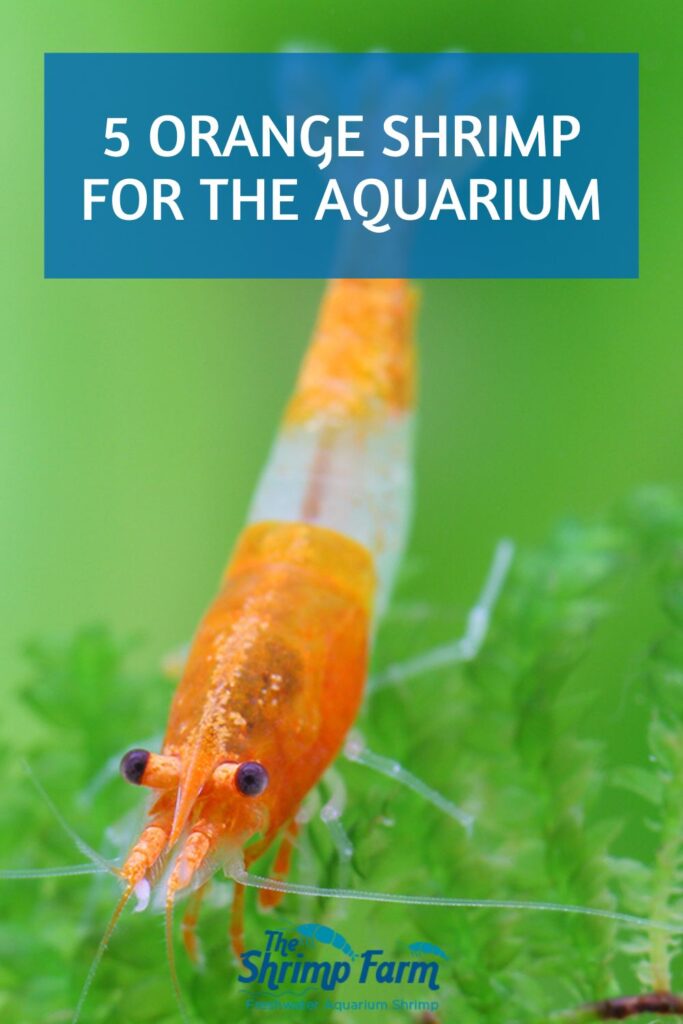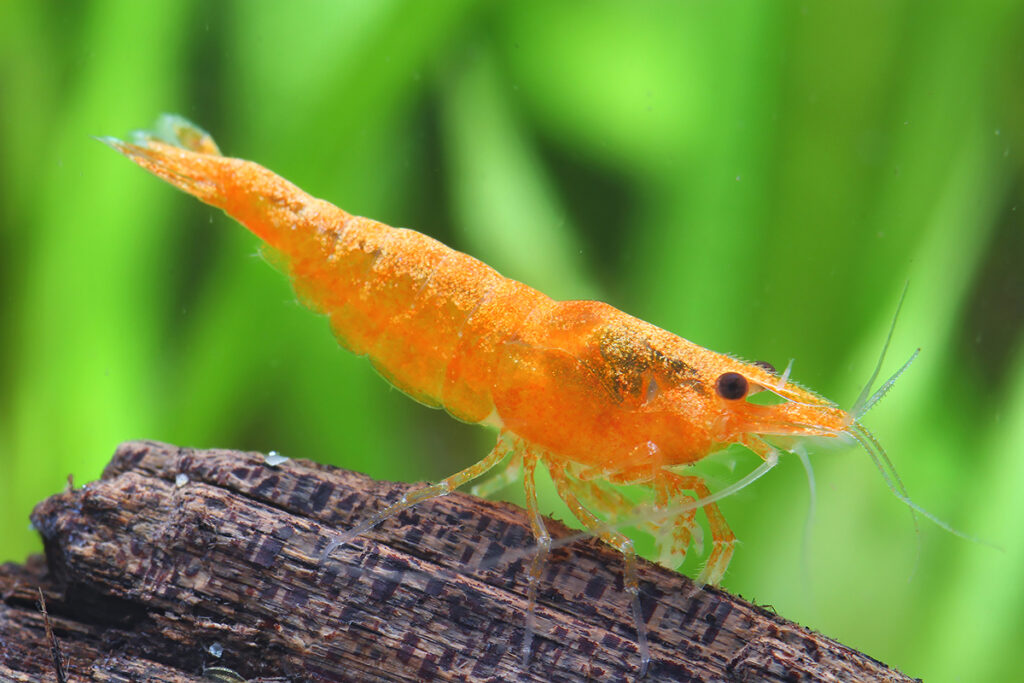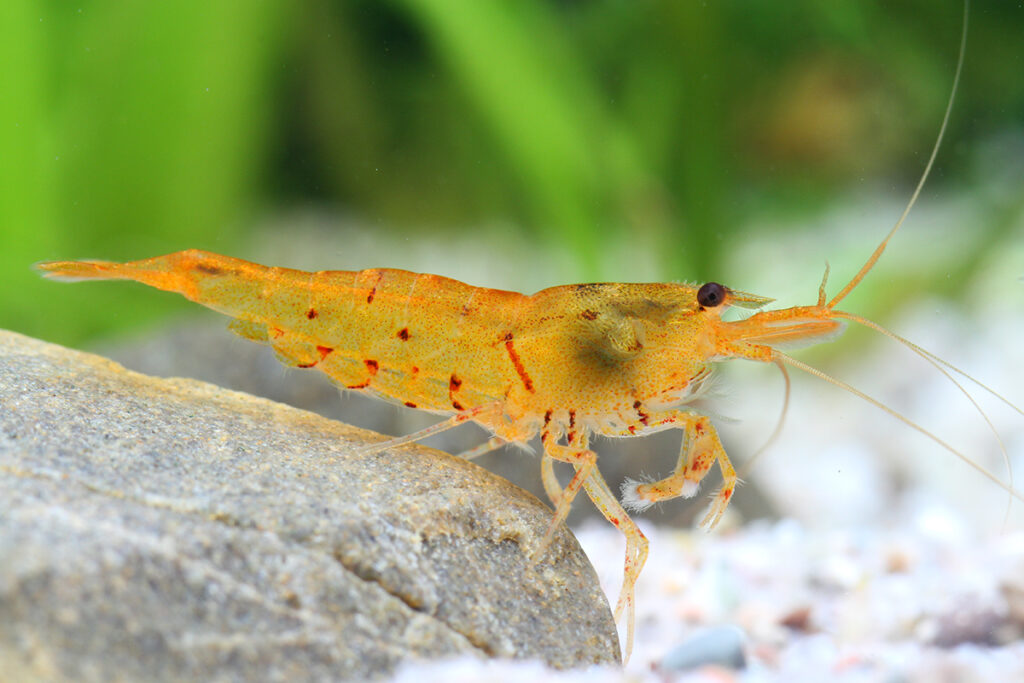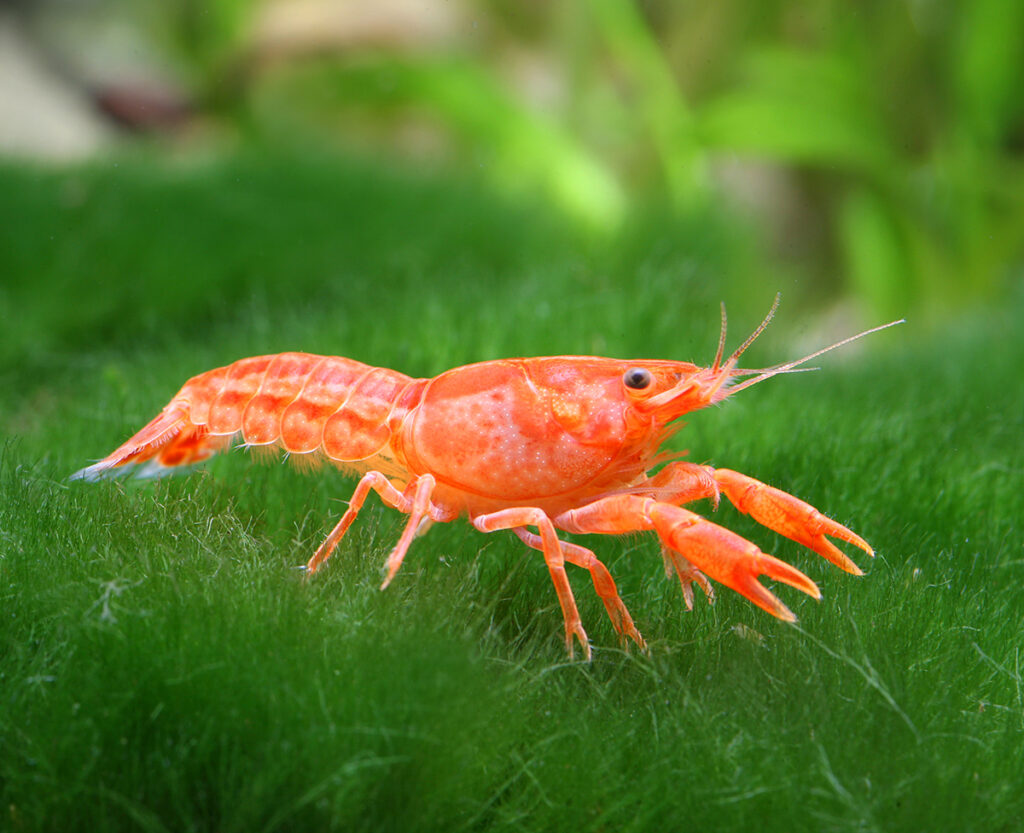Orange shrimp aquarium | 5 beautiful orange shrimp
Love the color orange? You'll be happy to find out that setting up an orange shrimp aquarium is a breeze: there are several different varieties of Neocaridina and Caridina shrimp available in this cheerful color.
Keep reading to find out 5 of our favorite species for an orange shrimp aquarium!
Orange rili shrimp (Neocaridina davidi 'Orange Rili')
You've heard of red rilis, blue rilis and maybe even carbon rilis... but did you know there are also orange rili shrimp? Their bright coloration perfectly complements the typical translucent body patches that make a rili shrimp a rili shrimp.
Being one of the many selectively bred varieties of the beginner-proof Neocaridina davidi species of dwarf shrimp, orange rili shrimp are undemanding and quick breeders. This means that even unexperienced aquarists will find keeping their colony happy and healthy a breeze.
You can combine orange rili shrimp with other species on this list. As long as they're not fellow Neocaridinas, they won't be able to interbreed. Try sunkist shrimp or tangerine tigers, for example!
Want to know more? You can read everything about caring for these colorful dwarf shrimp in the full orange rili shrimp care guide.
Orange sakura shrimp (Neocaridina davidi 'Orange Sakura')
You're not seeing double: the orange sakura shrimp is very visually similar to its orange rili cousins. That's not surprising, since they're both selectively bred varieties of Neocaridina davidi dwarf shrimp. The difference is in the fact that orange sakuras lack the translucent patches that all rili shrimp have.
You may find the cheerful orange sakura for sale under several different names. For example, they're sometimes referred to as sunkist shrimp, but that's actually the common name for a species from a different genus that we'll discussed below. You may also see them listed as orange pumpkin shrimp or just plain "orange shrimp".
Whatever their denomination, these orange dwarf shrimp are easy to keep and reproduce readily in the aquarium. You can read more about their care in the full orange sakura shrimp care guide.
Tangerine tiger shrimp (Caridina serrata 'Tangerine Tiger')
Let's move from Neocaridina to Caridina! Caridina serrata 'Tangerine Tiger', commonly known as the tangerine tiger shrimp, is one of the brightest choices for an orange shrimp aquarium. They don't just sport a bright tangerine color throughout their bodies, but also subtle red stripes for some extra pizazz.
As mentioned earlier, you can combine tangerine tigers with Neocaridina shrimp, like the ones discussed above, without running the risk of them interbreeding and muddling the genetics. Do keep in mind that they can be a little more sensitive than their Neo cousins, so it's important to keep the water quality high.
You can find everything you need to know about caring for these dwarf shrimp in the full tangerine tiger shrimp care guide!
Sunkist shrimp (Caridina thambipillai)
Remember when we said that the orange sakura shrimp of the Neocaridina genus is sometimes referred to as sunkist shrimp? The reason that can be confusing is because there already is a sunkist shrimp, although it's much less common in the hobby than the orange sakura. Its scientific name is Caridina thambipillai.
Although the sunkist shrimp was first described by Westerners in 1961 after having been discovered in Malaysia, it hasn't reached the stardom status in the aquarium that some of its cousins have. It's a relatively obscure species, although some aquarium stores may be able to order a few for you if you ask them. We'd say it's worth it: that slightly speckled orange coloration makes this species quite the eye-catcher!
Keep in mind that Caridina thambipillai is a lower-order shrimp. Like the popular Amano shrimp, its larvae require a period in brackish water in order to grow. This makes breeding the species a bit of a challenge, but it has been done (note that the author mistook his shrimp for Caridina propinqua at first; see more about those below).
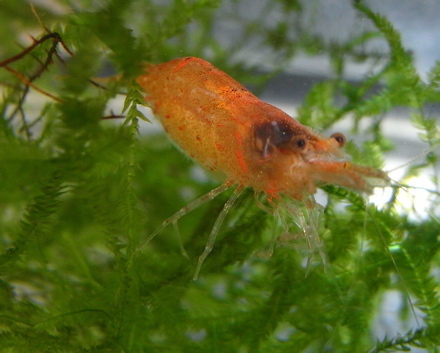
Orange bee shrimp (Caridina propinqua)
Another more obscure species for an orange shrimp aquarium is Caridina propinqua (occasionally Caridina cf propinqua). In the hobby, this one's sometimes referred to as the orange bee shrimp. It sports a deep, somewhat translucent shade of orange, often with white speckles dusting the body.
Given that the first specimens of orange bee shrimp collected by Westerners were actually found in brackish waters (in eastern Bengal, India), you won't be surprised to learn that, like the aforementioned sunkist shrimp, this species needs lightly salted water to reproduce. It's a lower-order shrimp that produces larvae rather than fully developed fry.
BONUS: Dwarf orange crayfish (Cambarellus patzcuarensis)
Okay... if you squint really hard, it looks like a shrimp. Additionally, it's a blindingly bright orange in color, so we think the dwarf orange crayfish (Cambarellus patzcuarensis, also known as CPO or Mexican dwarf crayfish) deserves a place on this list.
Although wild-type CPO crayfish are a murky brown in color, selective breeding of spontaneous mutations has produced a cheerful orange version that's much more popular in aquaculture today than the original. They're the ideal aquarium inhabitants: they do well in small tanks of 5 gallons or up, will cohabit peacefully with shrimp and are even quite easy to breed. If you're looking for a pop of color in your small aquarium, give them a try!
You can find everything you need to know about caring for these small crays in the full dwarf orange crayfish care guide.
Other shrimp colors
Looking for something other than orange to brighten up your aquarium? Check out our guides on:
Sources
De Man, J. G. (1908). The Fauna of Brackish Ponds at Port Canning, Lower Bengal. X. Decapod Crustacea, with an Account of a Small Collection from Brackish Water near Calcutta and in the Dacca District, Eastern Bengal. Records of the Zoological Survey of India, 2(3), 211-231.
Johnson, D. S. (1961). Notes on the freshwater Crustacea of Malaya. I. The Atyidae. Bulletin of the Raffles Museum, 26, 120-153.



 Shrimp
Shrimp Fish
Fish Crab &
Crab & Plants
Plants Foods
Foods Snails
Snails